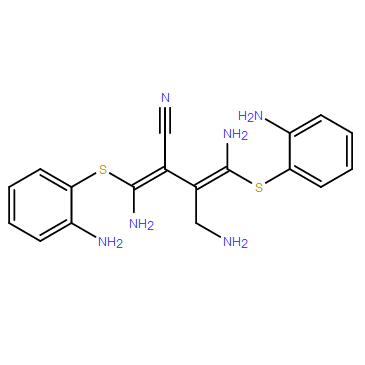| Cas No.: | 109511-58-2 |
| Synonyms: | U0126,U 0126 |
| SMILES: | NC1=CC=CC=C1S/C(N)=C(C#N)/C(C#N)=C(N)/SC2=CC=CC=C2N |
| Formula: | C18H16N6S2 |
| M.Wt: | 380.49 |
| Purity: | >98% |
| Sotrage: | 2 years -20°C Powder, 2 weeks 4°C in DMSO, 6 months -80°C in DMSO |
| Description: | U0126 is a potent, non-ATP competitive and selective MEK1 and MEK2 inhibitor, with IC50s of 72 nM and 58 nM, respectively. U0126 is an autophagy and mitophagy inhibitor[1][2][3][4]. |
| Target: | MEK2:60 nM (IC50) MEK1:70 nM (IC50) |
| In Vivo: | Mice are treated daily with U0126-EtOH (U0126; i.p., 10.5 mg/kg). In control experiment, tumor sizes are constant or slightly increase all over the kinetic. At the opposite, in all U0126-EtOH experiments, engraftment and early tumor growth are significantly decreased. Furthermore, a 60-70% reduction in the volume of tumors treated with U0126-EtOH is obtained 9 days after injection and thereafter[3]. Rats are subjected to 120 minutes transient middle cerebral artery occlusion (tMCAO) and thereafter treated with the U0126-EtOH (U0126; i.p., 30 mg/kg) at 0 and 24 hours of reperfusion. After treatment with U0126-EtOH, the vasoconstriction to S6c is markedly reduced[4]. Animal Model: Athymic female nude mice (SWISS, nu/nu)[3]. Dosage: 10.5 mg/kg. Administration: Intraperitoneal injection daily. Result: Inhibited tumor growth. Animal Model: Twelve-week-old female Wistar rats (250 to 265 g) [4]. Dosage: 30 mg/kg. Administration: Intraperitoneally. Result: The vasoconstriction to S6c is markedly reduced. |
| In Vitro: | Treatment with U0126 efficiently reduces progeny virus titers of all tested strains in A549 cells. While nM concentrations of U0126 are efficient to reduce H1N1v and H5N1 (MB1), μM concentrations of U0126 are required to reduce the virus titer of H5N1 (GSB) and H7N7. The EC50 values for U0126-EtOH against H1N1v are 1.2±0.4 μM in A549 cells and 74.7±1.0 μM in MDCKII cells[2]. Rat hepatocarcinoma cells (FAO) stimulated by fetal calf serum (FCS) exhibits a significant proportion in S phase (32.62%) whereas U0126 strongly decreases the proportion of cells in S phase (9.92%) and increases the proportion of cells in G0-G1 phase and to a lesser extent in G2/M[3]. Cell Viability Assay[2] Cell Line: A549 and MDCK II cells. Concentration: 0.001-1000 μM. Incubation Time: 48 h. Result: The EC50 values for U0126 against H1N1v were 1.2 ± 0.4 μM in A549 cells and 74.7 ± 1.0 μM in MDCKII cells |
| References: | [1]. Favata MF, et al. Identification of a novel inhibitor of mitogen-activated protein kinase kinase. J Biol Chem. 1998 Jul 17;273(29):18623-32. [2]. Droebner K, et al. Antiviral activity of the MEK-inhibitor U0126 against pandemic H1N1v and highly pathogenic avian influenza virus in vitro and in vivo. Antiviral Res. 2011, 92(2), 195-203. [3]. Bessard A, et al. RNAi-mediated ERK2 knockdown inhibits growth of tumor cells in vitro and in vivo. Oncogene. 2008 Sep 11;27(40):5315-25. [4]. Ahnstedt H, et al. U0126 attenuates cerebral vasoconstriction and improves long-term neurologic outcome after stroke in female rats. J Cereb Blood Flow Metab. 2015 Mar;35(3):454-60. |

 To enhance service speed and avoid tariff delays, we've opened a US warehouse. All US orders ship directly from our US facility.
To enhance service speed and avoid tariff delays, we've opened a US warehouse. All US orders ship directly from our US facility.




















